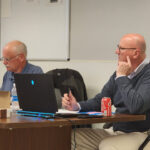CARIBOU, Maine — With the COVID-19 pandemic causing students and teachers to finish the school year in remote learning and reconsider graduation and related plans, the RSU 39 board recently discussed how to tackle the beginning of the school year based on various scenarios.
Superintendent Tim Doak outlined three possible plans for fall 2020 during the meeting Wednesday which was held over Zoom video conferencing and live streamed on YouTube.
In Plan A, students, teachers and staff members return to school on their usual date and in-person instruction resumes without restrictions.
The uncertainty surrounding COVID-19 leaves the district unsure of whether Maine CDC and state social distancing guidelines will still be in effect in late summer and early fall, Doak said.
In Plan B, everyone will have to be 6 ft apart and wear masks because of a lack of a vaccine.
“It makes me concerned about the bus runs, what physical education will look like, what music instruction and band practice will look like. And what about the cafeteria? Students might have to eat in their classrooms,” Doak said.
With Plan C, remote learning would continue as it has throughout the remainder of the 2019-20 school year, but likely with more opportunities for teachers to take part in training designed to better equip them to use online learning tools.
Though the school board made no formal decisions regarding the mode of instruction, Doak emphasized that he brought up the discussion so that people will understand what scenarios the school might be facing in the fall.
“I think I go too fast sometimes and scare people who aren’t ready to think that far ahead, but we have to look at what would work and what would not work,” Doak said.
In a related update to the board, Jane McCall, assistant superintendent of curriculum and instruction, addressed concerns from teachers about a slight decrease in student engagement with fully online coursework.
“As expected, after April vacation we started to see some students with less engagement. A lot of it is COVID-19, but we also have ‘spring fever’ once the warm weather comes,” McCall said.
McCall said there has not been a major decrease in participation when asked by board member Jan Tompkins if the decrease has been “significant.” But teachers have been reaching out to students who have recently not been in regular contact with them.
“We don’t want to lose even 5 or 10 percent,” McCall said.
McCall and a group of teachers from all grade levels are creating a remote learning task force to discuss what everyone has learned from the recent “emergency remote learning,” and how they can use their experiences to better implement online instruction in the future, she said.
“One of the goals we have is to implement online learning into our curriculum on a regular basis, so we don’t get caught in this situation again,” McCall said. “Different grade levels will utilize it in different ways, but [online learning] should not be something we use just during this pandemic.”
Doak and school board members expressed interest in increasing the use of online tools even when instruction transitions fully back to in-person classes.
Board member Tanya Sleeper, a professor in adult health nursing at the University of Maine at Fort Kent, said that she has taught “dual-model” classes that combine in-class and online instruction.
“I teach on campus, but I also have a completely online course that coincides. When I lecture in person, students also have that lecture online as an audio presentation,” Sleeper said. “There are ways to build in engaging lessons and I think there is value in reaching out to the universities to see what other instructors do.”
Doak agreed and said that he has been in contact with university officials to discuss online teaching options. For instance, if high school students graduate with two or three fully online courses under their belts, they could be more prepared for taking similar classes in college.
Regardless of what form the new school year takes, Doak said that the challenge will be in rethinking how teachers at all grade levels utilize in-person and/or online instruction to best serve students.
“My worry is the loss of [in-person] instruction and that has nothing to do with our teachers. It’s the situation we’ve been put into,” Doak said. “We need some way to integrate in-person and online, with the proper training.”






